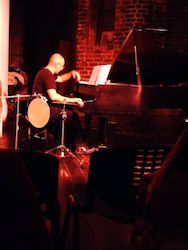
 |
Short History of the Pianoforte
Keyboard instruments have existed since the middle ages. The organ, the oldest keyboard instrument, has been played for several centuries. It is likely that the use of keys to produce music was popularized by the organ, compelling the invention of different types of keyboard instruments. The organ, however, is a wind keyboard, and is almost entirely unrelated to the piano. The first keyboard instrument that used strings, the clavichord, came to be in the late Middle Ages, although nobody knows exactly when it was invented. The clavichord had an action similar to that of the piano, but the tone it produced was much softer and too quiet to play in a concert. A small clavicord makes a sound that is easily covered by the noise produced by a refrigerator. The clavichord was also much smaller and simpler than its relative, the harpsichord. For these reasons, it was a popular household instrument, and could be found in the homes of several Baroque composers, including J.S. Bach. The clavichord had a very simple action. When pressed, the key lifted a tangent, a small copper square, which struck the string, as well as lifting a damper, which allowed the strings vibration to be sustained as long as the key was held. The clavichord had one string per key, sometimes one for two keys, while a modern grand piano contains up to three strings per key. While the small tangent and the small number of strings made the clavichord a very quiet instrument, the tangent allowed for Crescendos and Diminuendos (gradual dynamic changes), as well as some semblance of a dynamic range. Of the early stringed keyboards, the clavichord was the most similar to the piano. The next keyboard instrument, chronologically, was the harpsichord, probably invented in the 15th century in Italy (Again, this information is not known). The harpsichord is an instrument much unlike the clavichord. Instead of striking the string with a tangent, the harpsichord uses a bird quill or a piece of hard leather (referred to as the plectrum) to pluck its strings. Also, the harpsichord’s strings run parallel to the keys, like a grand piano, whereas a clavichord has strings perpendicular to the keys, like a modern upright piano. When a harpsichord is played, the key lifts a jack, which pushes the plectrum against the string, causing the string to be plucked. Like the clavichord, the harpsichord contains a damper to cut off the vibration as soon as the key is released The third type of stringed keyboard instrument is the virginal, also called the spinet. The virginal was an instrument used in the 15th, 16th and early 17th centuries, and is actually a small harpsichord, consisting of either one or two sets of keys, each with a 4-octave range. Around the turn of the 18th century, composers and musicians were looking for a new kind of keyboard instrument. Some were looking to recreate the effects produced by dulcimer virtuoso Panteleon Hebenstreit (1669-1750). Others sought a keyboard instrument as powerful and as expressive as the violin. Most of all, they needed a keyboard with a large dynamic range that could play very loud or very soft, and that could change the dynamics smoothly and subtly. Their wish came true in 1709, when Bartolommeo Cristofori, curator of musical instruments for the Medici family, invented the first piano. He called his invention a gravicembalo col piano e forte-a "keyboard instrument that can be played soft and loud." This name was shortened to "pianoforte," (soft-loud) and eventually to just "piano." The action of Cristofori’s piano was very simple. It contained only the key, a felt hammer and an escapement, with no dampers or pedals. The key would push up the hammer against the string, causing a vibration unlike that of the harpsichord or the clavichord. The escapement allowed the hammer to fall after being pushed up. Without the escapement, the hammer would remain pressed against the string as long as the key was held down, which would deaden the string. Later, in the 1800s, a double escapement was invented, which allowed the hammer not to fall the whole way back down, allowing for quicker repetition of notes and faster trills. What makes the piano a truly wonderful instrument is its resonance and its dynamic range. A wooden case, held up with a steel frame (Not invented until the 19th century; Cristofori’s was just made of wood), allows the instrument to have a ringing sound, especially noticed when it is played forte (loud). The dynamic range of the piano is also quite noteworthy. The hammering action and the range in vibration of the strings allows it to be played in any dynamic, from pianissimo (very soft) to fortissimo (very loud). What sets the piano apart from other keyboards is its ability to play not only soft and loud, but to make crescendos and diminuendos and change dynamics very quickly or very gradually. When the piano came into popularity, Europe was in the transition between the Baroque and Classical periods. In the classical period, the piano became very popular as both a household and concert instrument. For many years, the Harpsichord had accompanied other instruments, and sometimes used as a soloist. However, the piano’s dynamics proved that a keyboard really could match the violin or trumpet as a solo instrument, and the piano took center stage at the concert halls of Europe’s cities. In the Romantic period, the piano became the most popular household instrument. Amateurs preferred the piano because they could play melody and harmony together. The rise in popularity brought about the rise of many piano virtuosos and what has been called "the Golden Age" of the piano. Over the past 300 years, few great composers, if any, did not write for the piano, and many of them have made great careers as piano composers and virtuosos. Even today, a good piano is found in the home of almost every musician and composer, however it has disappeared from many households as the primary source of music entertainment perhaphs due to the enourmous variety of music reproduction systems which became available in the 20th century.



 |
||
|